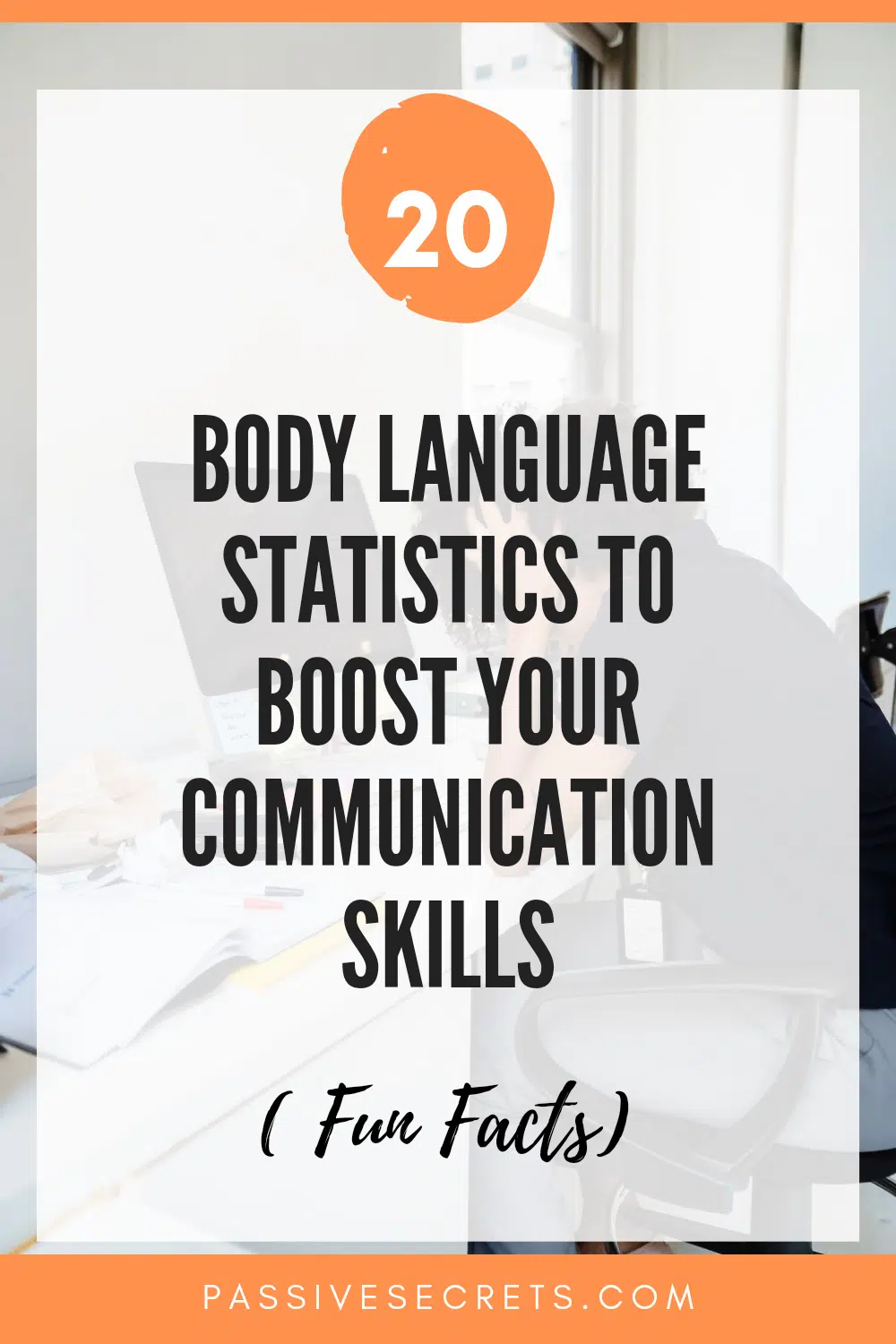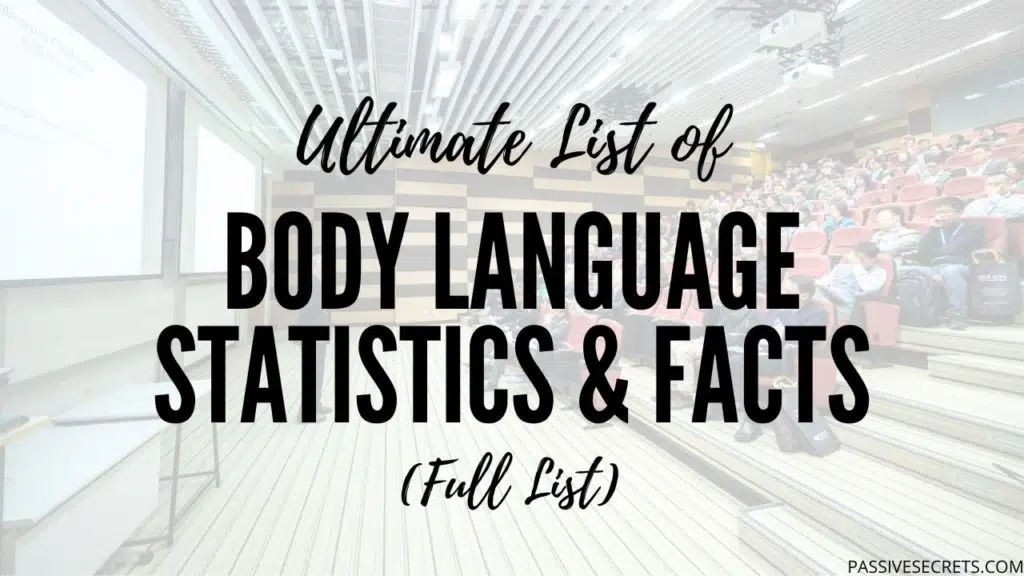
Body language is how we express ourselves without words. It’s all about micro-expressions and subtle gestures that reveal what we think, not what we want others to think.
Statistics show that over 70% of communication is non-verbal, so it’s important to understand body language and know how to communicate and listen well.
In this article, I gathered essential body language statistics that illustrate body language’s vital role in our everyday interactions.
Key Highlights: Most Interesting Body Language Stats
- Only 7% of communication is verbal, while 38% is attributed to tone of voice and 55% to body language, highlighting the significance of non-verbal cues.
- Non-verbal communication is 65%-93% more influential than text, emphasizing its impact in conveying messages.
- The seven primary elements of body language include body movement, posture, facial expressions, space/distance, touch, voice, gestures, and eye contact.
- Non-verbal communication is more noticeable than verbal communication, accounting for 93% of the meaning people understand.
- Body language, facial expression, style, and tone account for 93% of the meaning people understand, emphasizing their role in communication.
- National Body Language Day falls on October 4th, 2024, promoting the understanding of body language as a powerful mode of communication.
- Non-verbal communication cues significantly influence the perception and processing of a message.
- Body language helps qualify a message, convey emotions and intentions, and regulate the flow of messages and feedback.
- Slight changes in nonverbal cues can immediately change the atmosphere and the audience’s engagement in a presentation.
- Negotiators who can’t see each other’s gestures and facial expressions find it difficult to read each other’s tone and build rapport.
What Is Body Language?
Body language uses physical cues, such as posture, gesture, and facial expression, to communicate non-verbally.
It is a form of nonverbal communication and can reveal much about a person’s feelings and intentions.
Body language is often used unconsciously, so people are unaware of the messages they send.
However, it can be an essential form of communication, particularly in situations where verbal communication is not possible or desirable.
Although people believe 70% of communication is nonverbal, another school of thought believes otherwise.
They say that no amount of our communication is non-verbal. In his research, Dr. Mehrabian has cautioned that his study does not apply to all contexts.
It is only applicable if the speaker talks about his feelings or attitude. But we can deduce from Dr Mehrabian’s research that our body language conveys far more information than what we say.
This is because if what we say and what our body language conveys contradict each other, people would be more likely to take our body language for it.
When communicating with someone, we should be cautious of our nonverbal cues.
Body Language Statistics
1. Only 7% of communication is verbal. The rest comprises 38% tone of voice and 55% body language. (source)
The way we carry ourselves speaks volumes. And yet, despite its importance, few of us know how to read and interpret body language.
This can be a huge disadvantage in our personal and professional lives.

2. Non-verbal communication or expression is 65%-93% more influential than text. (source)
So, even in your interviews, your body language and composure speak more than what you say.
3. There are SEVEN main elements of body language, which include:
- Body movement and posture
- Facial expressions
- Space/distance
- Touch
- Voice
- Gestures
- Eye contact (source)
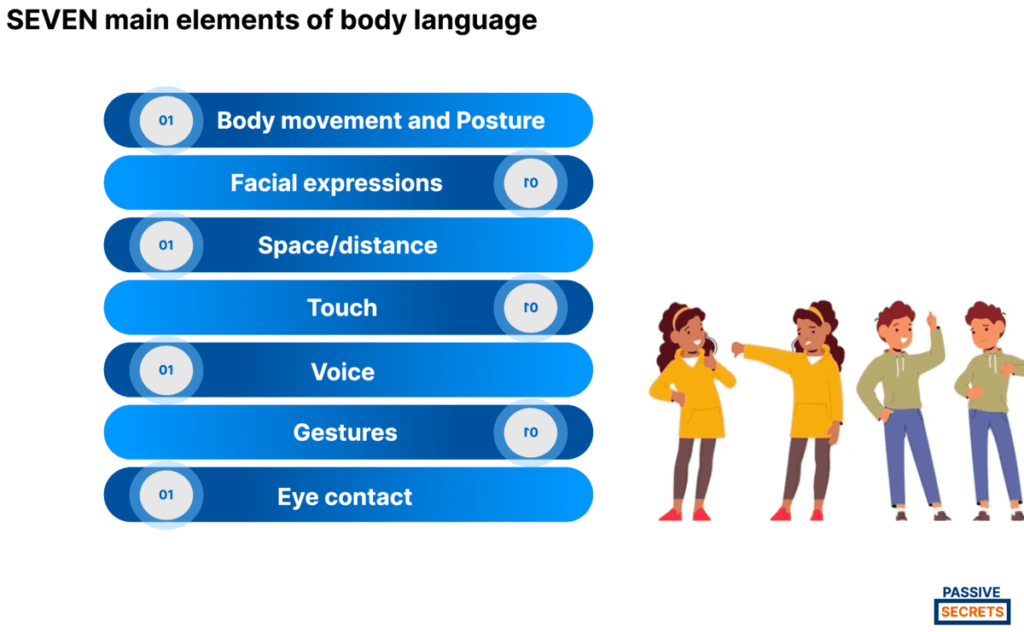
4. Non-verbal communication is MORE noticeable than verbal communication. (source)
5. Body language, facial expression, style, and tone accounted for 93% of the meaning people understand. (source)
6. There is a national body language day. And this year, it will fall on October 4th, 2024. (source)
National Body Language Day aims to help people realize the power of body language as a powerful mode of communication.
7. Non-verbal communication cues can influence the perception and processing of a message. (source)
8. Body language helps qualify a message, convey the right emotions and intentions behind the message, and regulate the flow of messages and feedback. (source)
9. A slight change of nonverbal cues can immediately change the atmosphere and the audience’s engagement towards the presentation. (source)
10. Negotiators who can’t see each other’s gestures and facial expressions find it difficult to read each other’s tone and build rapport. (source)
11. Most adults make eye contact in a conversation between 30%–60% of the time. However, the ideal percentage should be 70% to create an emotional connection. (source)
12. Maintaining eye contact with the other party you are discussing for 4-5 seconds is recommended before looking away and looking back again for another 4-5 seconds. (source)
This is because looking/staring at someone 100% of the time can appear creepy or intimidating.
13. It is believed that maintaining eye contact is easier when listening than when speaking. (source)
14. The human face has 43 muscles and can make up to 10,000 expressions. (source)
15. There are SEVEN universal facial expressions as modes of communication:
- Fear
- Disgust
- Happiness
- Sadness
- Anger
- Contempt
- Surprise (source)
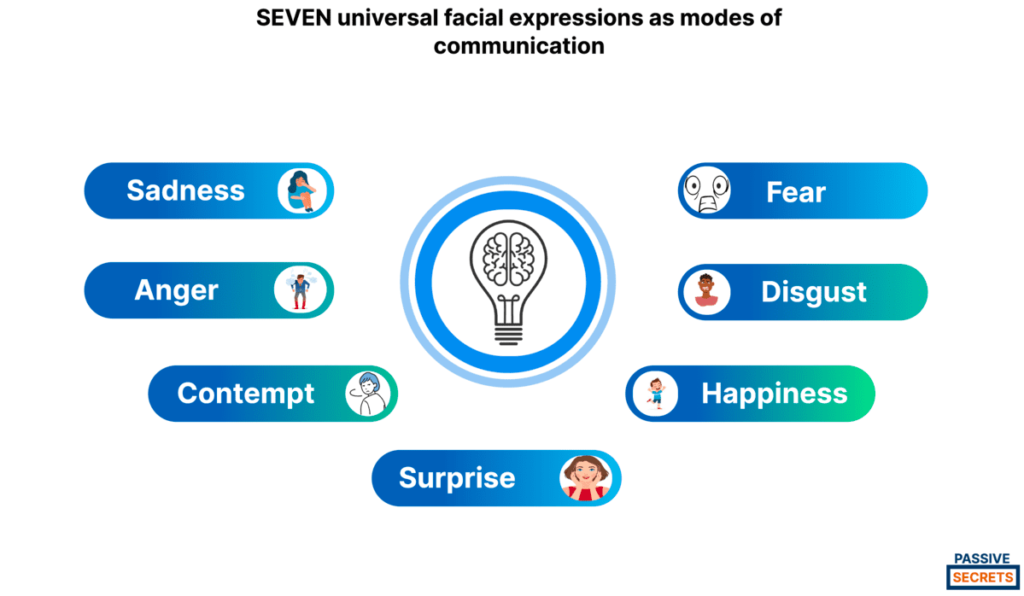
16. Body language does not contain grammatical rules, and the interpretations may differ in different cultures and countries. (source)
17. Non-verbal cues could help to project 10× more confidence, build rapport, and sustain connections. (source)
18. Body language means different things to different cultures worldwide. For example, maintaining eye contact could mean different things for various continents.
- In North America, it signifies confidence.
- In Europe, it signifies attentiveness,
- In Latin America, it signifies a certain level of friendliness.
- In Africa, it signifies respect or humility. (source)
19. Body language can be accurately read by paying attention to communication inconsistencies and trusting your instincts. (source)
20. Non-verbal signals can be evaluated through many factors such as Eye contact, Tone, Touch, Facial expression, and Posture. (source)
Body Language Facts
The way we stand, where we put our hands, and how we look at someone are all signals that reveal what we think or feel. Body language is vital in social interactions, especially in professional settings.
The most successful people know how to use body language to their advantage. Here are some exciting and fun body language facts:
1. Body language is Unconscious
Most of the time, we are unaware of our bodies’ signals. For example, we may not realize we are fidgeting or biting our nails.
However, these unconscious gestures can give others clues about our feelings.
For example, someone nervous may start to sweat, have a racing heart, and start tapping their fingers unconsciously.
2. Body Language can be Contagious
People tend to mirror the body language of those they are speaking to. This is known as the chameleon effect because people want to appear similar to others to build rapport.
Adapting to our surroundings by becoming a more appropriate version of ourselves is human nature. It’s a straightforward modification.
As a result, we benefit from each other’s energy, which happens unconsciously.
3. Crossing Your Arms Makes You Appear Closed Off and Unapproachable
When you cross your arms, you are essentially creating a barrier between yourself and the other person. It might seem harmless, but the message it’s passing on says otherwise.
4. Slouching Can Make You Appear Disinterested and Lacking in Confidence
When slouching, you send signals that you’re not interested or comfortable.
Moreover, a reclined position can make you feel less confident and relaxed. And if you’re feeling less secure, you’ll probably come across as less confident as well.
5. Maintaining Eye Contact Shows that You are Actively Listening and Interested
Researchers discovered that making effective eye contact helps people focus on what the other person is saying. It can help you enhance your conversational listening abilities.
Looking at the other person’s eyes while they are speaking might convey that you are paying attention and increase mutual respect.
6. Smiling Makes You Appear Friendly and Approachable
When you smile, you become more appealing than when you do not. This small change allows you to interact with people, leaving you feeling less alienated or alone, which is essential for feeling better.
7. Body Language is Mostly Culturally Bound
While there are some universal aspects of body language, such as smiling, to indicate happiness, a large part of body language is culturally bound.
For example, in some cultures, eye contact is considered rude or aggressive; in others, it is seen as a sign of respect.
Similarly, how people use their hands to communicate can vary significantly from culture to culture.
For example, pointing is considered extremely rude in some cultures, while in others, it is seen as a completely normal gesture.
Understanding the cultural context of body language is crucial to interpreting it correctly, avoiding miscommunication, and building relationships with people from different cultures.
8. Micro-expressions are Better Indicators of True Feelings
Micro-expressions are extremely quick facial expressions that can last as little as half a second.
They are often involuntary and can be challenging to control, making them more accurately reflect someone’s true feelings than other expressions, such as smiles or frowns.
Some studies have found that micro-expressions can be up to seven times more accurate than basic expressions in identifying a person’s genuine emotions.
While microexpressions can be difficult to spot, there are some indicative signs that you can look for.
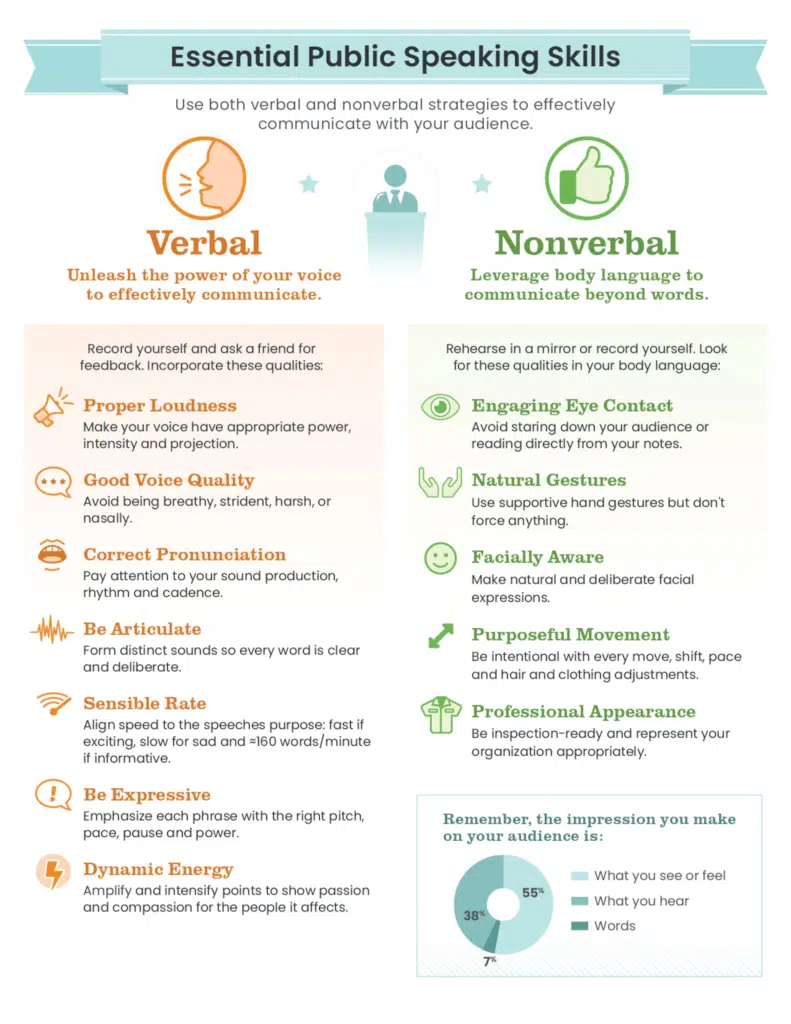
Verbal Vs. Non-verbal Communication
Verbal communication is exchanging information, feelings, and thoughts through speech or spoken words. Nonverbal communication, on the other hand, is the exchange of messages without using spoken words.
Instead of spoken words, nonverbal communication uses sign and body language.
In verbal communication, exchanging messages is very fast, resulting in rapid feedback. However, nonverbal communication is based on understanding, which takes time and thus is comparatively slow.
Although verbal and nonverbal communication are different, they are critical skills for public speaking and sales.
What percentage of communication is nonverbal?
According to the research of Albert Mehrabian, a renowned expert in the field of body language and communication, he found that communication is 55% nonverbal, 38% vocal, and 7% words only. This breakdown emphasizes the significant role of nonverbal communication in conveying messages. Additionally, Allan and Barbara Pease, authors of The Definitive Book of Body Language, analyzed thousands of recorded sales negotiations and found that body language accounted for the majority of the impact made during negotiations. Their research further underscores the substantial influence of nonverbal communication in interpersonal interactions.
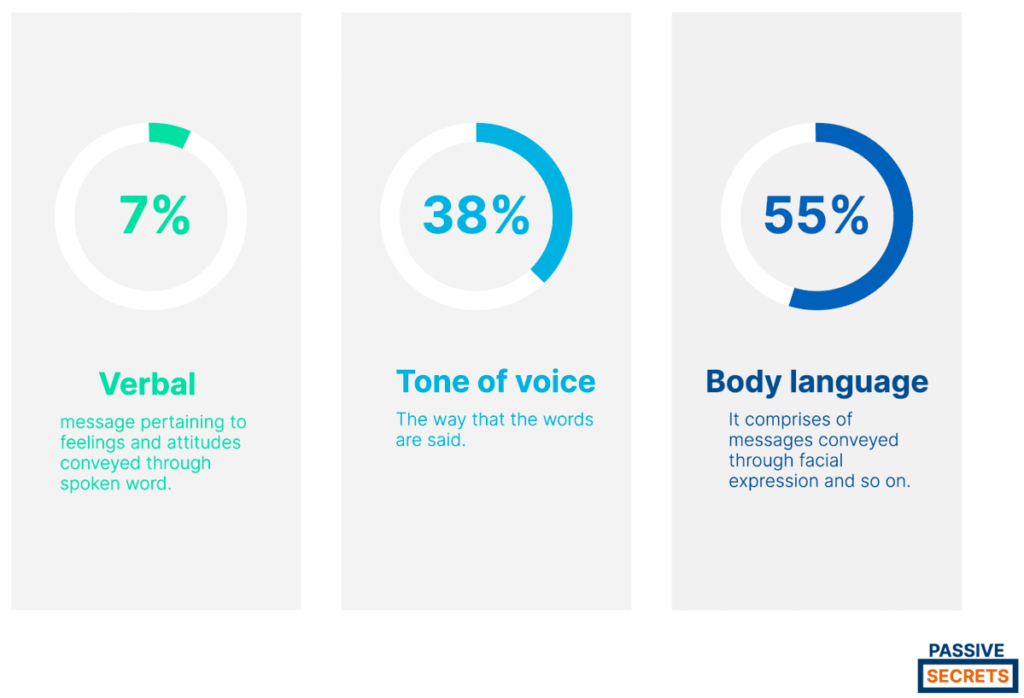
Four Main Types Of Body Language
Your body language communicates a lot about how you’re feeling, and it can be helpful to know the different types. Here are some common types of body language and what they might mean.
Facial Expressions
Your face is the most expressive part of your body. And, as it turns out, your facial expressions can reveal much about what you’re thinking and feeling.
In fact, research has shown that people can reliably guess what emotions you’re experiencing just by looking at your face.
Gestures
Gestures are intertwined with our daily lives. For example, when debating or speaking animatedly, you may wave, point, beckon, or use your hands, often expressing yourself with gestures without thinking.
However, the meaning of some gestures differs significantly among cultures.
For example, while the hand gesture “OK” transmits a good message in English-speaking countries, it is considered offensive in countries such as Germany, Russia, and Brazil.
As a result, it is critical to use caution when using gestures to avoid misinterpretation.
Posture
How you sit, stand, or move can convey your feelings and intentions. For example, good posture conveys confidence and power, while poor posture can make you seem weak and insecure.
You can use your posture to make an excellent first impression or to show your disinterest in someone.
Stance, bearing, and tiny motions all contribute to nonverbal communication.
Eye Contact
Eye contact is one of the most essential types of body language. It can communicate interest, concern, hostility, or attraction.
Maintaining eye contact with someone shows that you are interested in what they are saying. It can also make you appear more confident and trustworthy.
Avoiding eye contact can make you seem untrustworthy, uninterested, or nervous. It can also make it difficult to understand what someone is saying.
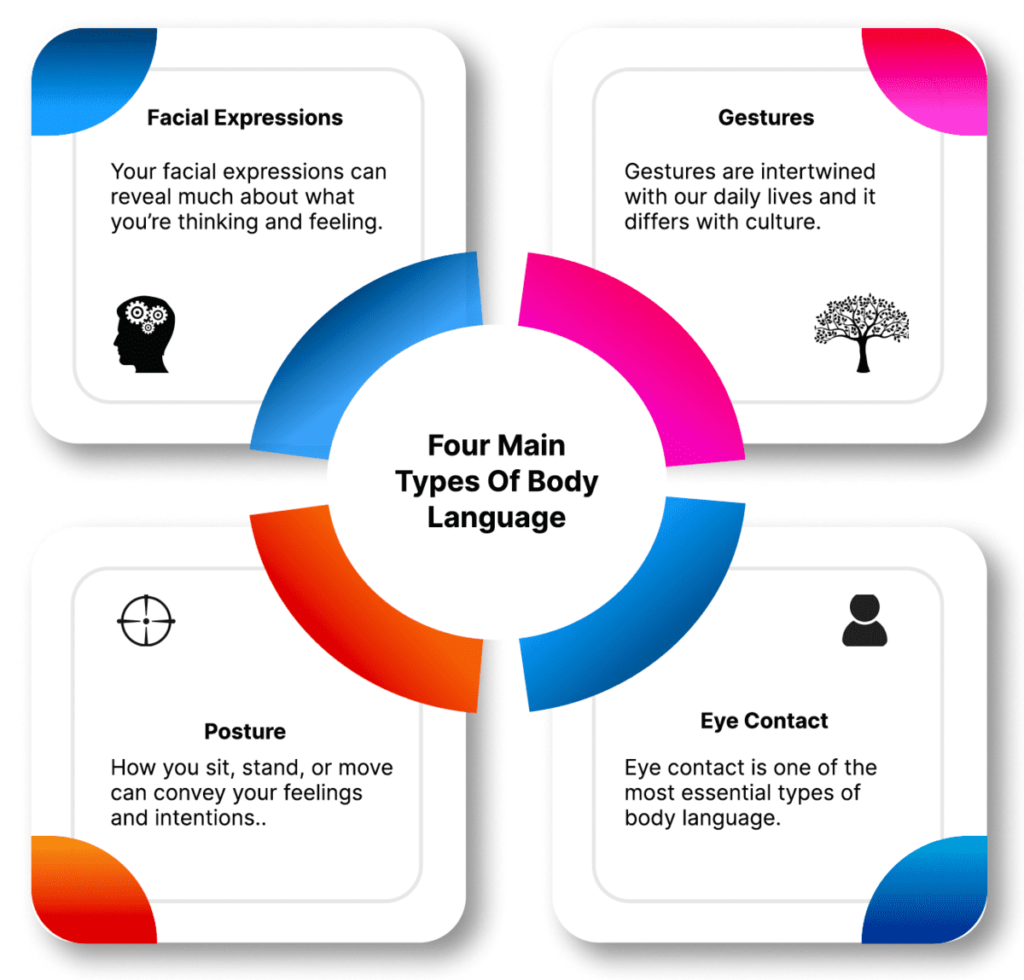
Conclusion
How we carry ourselves says much about who we are and how we want others to see us. And body language is often the most revealing.
While each person has their unique body language, specific signals tend to stand out as unique to a person’s identity.
Although body language is easy to overlook, it can tell much about a person. This article has provided several exciting body language statistics and facts you should know.
Body language is a meaningful way to communicate with others; you can convey honesty, confidence, and many different emotions with your body.
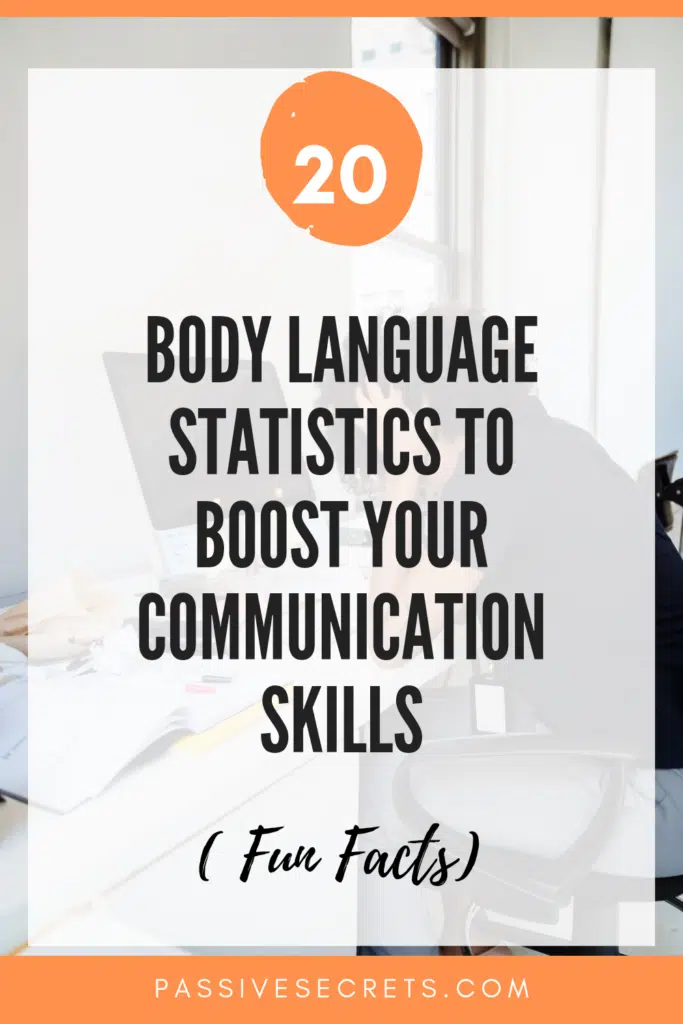
Related Posts:
- 47+ Important 4-day Work Week Statistics [2024]
- Incredible Women in Leadership Statistics: Insights into Global Gender Representation
- Billionaire Statistics: Surprising Insights About The World’s Wealthiest
- 89 Business Loan Statistics Every Entrepreneur Should Know
- 70+ AI in Education Statistics That Prove the Future Is Already Here
- Soft Skills Statistics: Key Data on Demand, Training, and Impact
- 95+ Fascinating Gift Industry Statistics to Surprise and Delight
- Top Business Coaching Statistics & Trends Every Leader Should Know
- How Much Are People Saving? Key Personal Savings Statistics Explained
- 40+ Useful Procrastination Statistics To Help You
- 90 Amazing Millionaire Statistics & Facts You Dare Not Miss
- 50+ Latest Life Coaching Statistics And Huge Trends
- 30+ Useful Real Estate Photography Statistics and Trends You Need to Know
- Data-Driven Decision-Making Statistics: Trends, Benefits & Challenges
- 54 Incredible Goal-Setting Statistics To Help You
- 45+ Interesting Communication Skills Statistics & Huge Trends
- 35 Interesting Public Speaking Fear Statistics & Fun Facts
- 25+ Most Interesting Emotional Intelligence Statistics & Fun Facts

